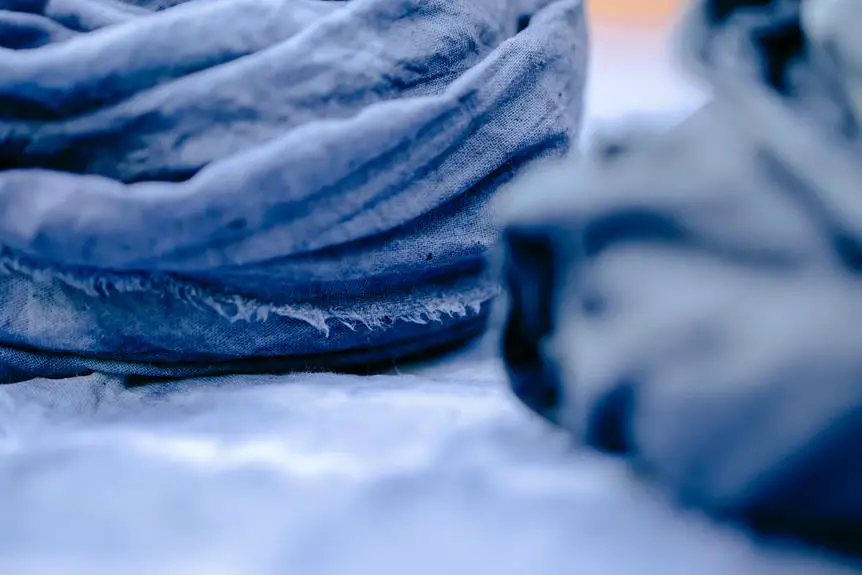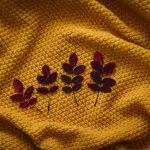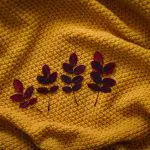Looking to add a splash of color to your wardrobe? Tie-dyeing your own fabrics is like creating a unique masterpiece on a blank canvas. With the right techniques and materials, it's easier than you think.
From choosing the perfect fabric to mastering folding and binding techniques, this guide will walk you through the process step by step. By the end, you'll have a collection of vibrant, one-of-a-kind creations that reflect your personal style.
So, roll up your sleeves and get ready to unleash your creativity with some easy, cool tie-dyeing.
Key Takeaways
- Choose natural fabrics like cotton or linen for the best tie-dye results
- Pre-wash the fabric and soak it in a mixture of water and soda ash before dyeing
- Experiment with different folding and tying techniques for unique tie-dye patterns
- Properly set the colors by heat setting, soaking in water and vinegar, and using a fixative or fabric softener
Choosing the Right Fabric
When choosing the right fabric for tie dye, focus on natural materials like cotton or linen for best results. These fabrics are excellent choices due to their ability to absorb and retain dye, resulting in vibrant and long-lasting colors.
Cotton is widely available, affordable, and easy to work with, making it a popular option for tie dye. It's also comfortable to wear and generally low-maintenance.
On the other hand, linen is known for its durability and breathability, making it a great choice for tie dye projects, especially for items like summer clothing or home décor.
Both fabrics offer their own unique advantages, so consider the specific needs of your project when making a selection.
Before diving into the tie dye process, it's crucial to prepare the fabric properly. Pre-washing the fabric is essential to remove any finishes, dirt, or sizing that may interfere with the dye's absorption.
Use a mild detergent and avoid fabric softeners, as they can leave a residue that affects the dyeing process. Additionally, pre-washing helps to preshrink the fabric, reducing the risk of distortion or color bleeding after the tie dye is completed.
Taking the time to prepare the fabric will ensure optimal results for your tie dye project.
Preparing the Dye
Before you start tie-dyeing, it's important to choose the right dye colors and mix the dye solutions. This will ensure that you achieve the vibrant and colorful designs you want on your fabric.
Take the time to prepare your dye properly to set the stage for successful tie-dye creations.
Choosing Dye Colors
To achieve vibrant tie-dye results, first gather a variety of dye colors based on the fabric you'll be using. Color coordination is essential when choosing dye colors for your tie-dye project. Consider the color wheel and choose colors that complement each other to create visually appealing patterns.
Additionally, take into account the fabric compatibility with the dyes. For natural fabrics like cotton and rayon, fiber-reactive dyes work best as they create long-lasting and vibrant colors. On the other hand, for synthetic fabrics such as polyester, nylon, or acrylic, opt for disperse dyes.
Understanding the compatibility of dyes with different fabrics ensures that the colors will bond effectively, resulting in beautiful and durable tie-dye creations. By carefully selecting dye colors based on color coordination and fabric compatibility, you set the stage for stunning tie-dye designs.
Mixing Dye Solutions
For mixing dye solutions to prepare the dye, start by selecting the appropriate dye colors based on fabric compatibility and color coordination as discussed in the previous section.
When mixing dye solutions, consider the following:
- Fabric types, dye compatibility: Different fabrics require different dye types. Ensure the dye is compatible with the fabric to achieve the best results.
- Temperature, dye stability: Pay attention to the temperature at which the dye solution is mixed. Some dyes may require specific temperature conditions for stability.
- Proportions, dye intensity: Carefully measure the dye and water proportions to achieve the desired intensity of color for your tie-dye project.
Folding and Binding Techniques
When creating tie-dye designs, start by folding and binding the fabric to create different patterns and shapes. Experiment with various folding patterns and binding materials to achieve unique and striking results. Consider using techniques like accordion folds, spiral patterns, or pleating to create visually appealing designs. Additionally, different binding materials such as rubber bands, strings, or even zip ties can be used to secure the folded fabric and create defined areas for the dye to penetrate.
Color combinations play a crucial role in tie-dye styles. When folding and binding the fabric, envision how the colors will interact and blend together. Think about the overall effect you want to achieve and how the colors will complement each other within the folded and bound areas. Whether you opt for bold contrasts or harmonious blends, the folding and binding techniques will influence how the colors merge and interact on the fabric.
Mastering folding and binding techniques is essential for creating intricate and captivating tie-dye designs. By understanding how different folding patterns and binding materials can influence the final outcome, you can elevate your tie-dye creations to new levels of artistry.
Applying the Dye
Now that you've mastered the folding and binding techniques, it's time to move on to applying the dye.
There are various dye saturation techniques you can use to achieve different effects, such as ombre or solid colors.
Additionally, color blending methods allow you to create unique and eye-catching patterns on your fabric.
Dye Saturation Techniques
To get the best results, carefully soak the fabric in the dye solution. Start by folding or tying your fabric to create unique tie dye designs. Consider using different fabric patterns to experiment with various dye saturation techniques. Apply the dye evenly and thoroughly to ensure vibrant and consistent coloration.
When saturating the fabric with dye, be mindful of the amount of dye used and the pressure applied. Take your time to apply the dye evenly, allowing it to penetrate the fabric for the desired effect. Experiment with different folding and tying techniques to create stunning patterns.
Color Blending Methods
Carefully consider the fabric patterns you're working with as you begin to experiment with color blending methods by applying the dye. Different fabric types absorb dye differently, affecting the final color outcome.
When selecting colors, keep in mind that they'll blend during the dye application process. To achieve vibrant, blended colors, carefully apply the dye, ensuring that the colors merge seamlessly. Start with light colors before moving on to darker ones, as this prevents the darker colors from overpowering the lighter ones.
Experiment with various dye application techniques such as folding, crumpling, or tying the fabric to create unique patterns. Remember that the way you apply the dye will influence the final design, so take your time and enjoy the creative process.
Setting the Colors
After applying the dye, you should start by setting the colors to ensure they remain vibrant and long-lasting. This step is crucial for achieving color fastness and preventing bleeding on different fabric types. Here's how you can effectively set the colors:
- Heat Setting: Use an iron to heat set the dyed fabric. Place a piece of cloth over the dyed area and iron it for a few minutes. This helps in setting the colors and prevents bleeding.
- Vinegar Soak: Soaking the dyed fabric in a mixture of water and vinegar helps in setting the colors. Mix one part vinegar with four parts water, soak the fabric for an hour, and then rinse it with cold water.
- Color Fixative: Utilize a commercial color fixative available at fabric stores. Follow the instructions on the product for the best results.
Ensuring that the colors are set properly won't only prevent bleeding but also enhance the longevity of the tie-dyed fabric. It's an essential step that shouldn't be overlooked to maintain the vibrancy of your creations.
Washing and Drying
Proper washing and drying of tie-dyed fabrics is essential for maintaining color vibrancy and longevity. When caring for your tie-dye creations, it's crucial to follow specific fabric care instructions to ensure colorfastness and preserve the design. Check the fabric label for washing guidelines, as some materials may require special treatment.
Here are some key fabric care tips for washing and drying tie-dyed fabrics:
| Fabric Care Tips | Description |
|---|---|
| Use Cold Water | Washing tie-dyed fabrics in cold water helps prevent color bleeding and fading. |
| Gentle Detergent | Use a mild, color-safe detergent to protect the vibrancy of the tie-dye design. |
| Avoid Direct Sunlight | When drying tie-dyed fabrics, avoid direct sunlight as it can cause colors to fade. |
| Air Dry or Low Heat | Opt for air drying or use a low-heat setting in the dryer to maintain fabric softness and prevent damage. |
| Keep Colors Separate | Wash tie-dyed items separately or with like colors to prevent color transfer. |
Following these fabric care and drying techniques will help preserve the integrity of your tie-dye creations and ensure that they remain vibrant and soft wash after wash.
Adding Finishing Touches
To enhance the visual appeal and durability of your tie-dye creation, finish the fabric by applying a fabric fixative according to the product instructions. Once your tie-dye fabric is fixed, consider adding embellishments and creative finishing touches to make it truly unique.
Here are some unique embellishment ideas to take your tie-dye creation to the next level:
- Embroidery: Use colorful embroidery floss to add intricate designs or patterns to your tie-dye fabric. This embellishing technique can create a stunning contrast and bring additional texture to your creation.
- Beading: Incorporate beads into your tie-dye fabric by hand-sewing them onto the design. Beads can add a touch of elegance and sparkle to your creation, making it stand out even more.
- Fabric Appliqué: Cut out shapes or designs from different fabrics and adhere them to your tie-dye fabric using fabric glue or stitching. Fabric appliqué can add depth and dimension to your creation, allowing you to personalize it further.
These creative embellishment techniques will elevate your tie-dye fabric, making it a one-of-a-kind piece that reflects your personal style and creativity.
Caring for Your Tie-Dye Creations
To keep your tie-dye creations vibrant and long-lasting, follow these tips:
- Gently wash them in cold water with mild detergent.
- Turn your tie-dye items inside out before washing to prevent fading.
- Wash them separately to avoid color bleeding onto other clothes.
- Hang your tie-dye items to air dry instead of using a dryer.
- Store them away from direct sunlight to prevent fading.
- Keep them in a cool, dry place to prevent fabric damage.
To further ensure the longevity of your tie-dye creations:
- Consider using a color-safe detergent designed to prevent fading.
- Avoid using bleach or harsh chemicals, as they can dull the colors over time.
With proper care and attention, your tie-dye items can remain vibrant and colorful for a long time to come.
Frequently Asked Questions
Can Tie-Dye Be Done on Synthetic Fabrics Like Polyester or Nylon?
Yes, tie-dye can be done on synthetic fabrics like polyester or nylon. You can use specific tie-dye techniques and colors designed for synthetic materials. Natural dyes may not work as well on synthetics.
Is It Possible to Tie-Dye Without Using Traditional Fabric Dyes, Such as Using Food Coloring or Natural Dyes?
Yes, it's possible to tie-dye without traditional fabric dyes. Using natural dyes or food coloring for tie dye is an option. You can experiment with unconventional dyes and different folding techniques for unique patterns. Special care is needed for tie-dyed fabrics.
Can I Use Pre-Made Tie-Dye Kits for This Project, or Do I Need to Mix My Own Dyes?
You can definitely use pre-made tie-dye kits for this project. They're convenient and come with everything you need. However, mixing your own dyes gives you more control over the colors and is great for tie-dye on denim.
What Are Some Alternative Folding and Binding Techniques That Could Create Unique Tie-Dye Patterns?
To create unique tie-dye patterns, explore Shibori techniques like folding, pleating, and binding to achieve distinct designs. Additionally, consider reverse dyeing, where you apply dye in a different order to create contrasting effects.
Are There Any Special Care Instructions for Tie-Dyed Fabrics, Such as Avoiding Direct Sunlight or Using Specific Laundry Detergents?
To keep your tie-dyed fabrics vibrant, follow special care instructions. Avoid direct sunlight to prevent fading and use specific detergents designed for colors to maintain the brightness of your tie-dye creations.
- How Does Ring Spun Cotton Affect Garment Fit and Shape Retention? - August 13, 2024
- What Are the Challenges in Producing Ring Spun Cotton? - August 13, 2024
- Is Ring Spun Cotton Suitable for Plus-Size Clothing? - August 13, 2024




